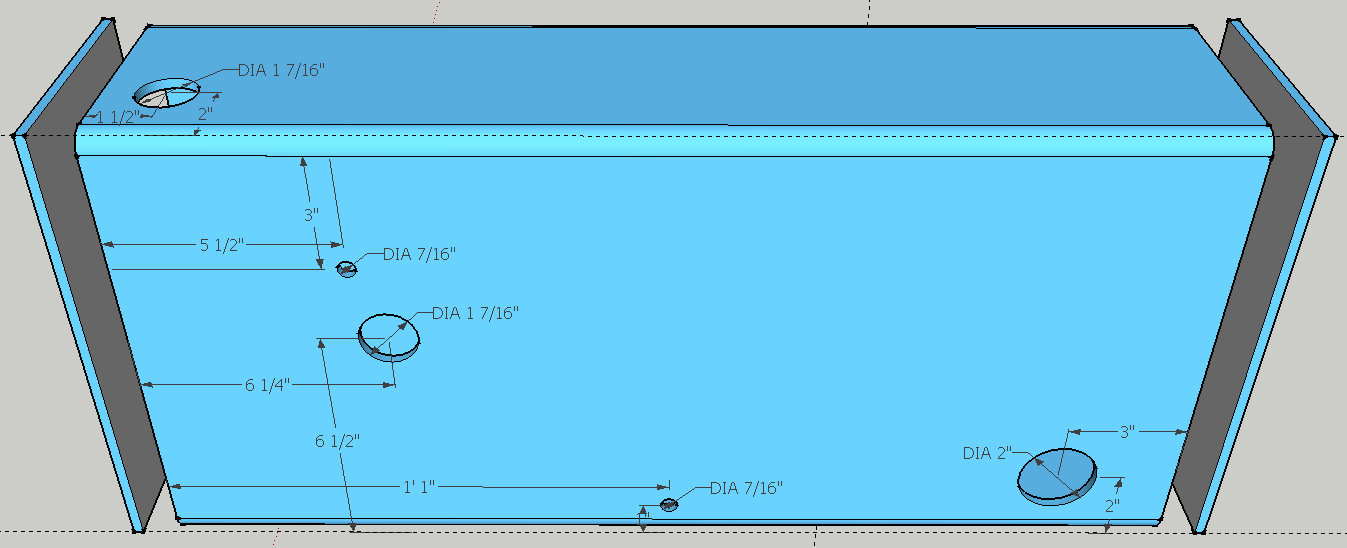PowerCube6 Hydraulic Reservoir: Difference between revisions
Jump to navigation
Jump to search
Tom Griffing (talk | contribs) (Created page with "Procedure for fabricating the hydraulic reservoir. Note that the preparation of the edges for welding is critical, as the welded seams must prevent fuel leaks. Part List: Recta...") |
Tom Griffing (talk | contribs) No edit summary |
||
| (3 intermediate revisions by the same user not shown) | |||
| Line 1: | Line 1: | ||
Procedure for fabricating the hydraulic reservoir. Note that the preparation of the edges for welding is critical, as the welded seams must prevent | Procedure for fabricating the hydraulic reservoir. | ||
Note that the preparation of the edges for welding is critical, as the welded seams must prevent fluid leaks. | |||
Part List: | Part List: | ||
* 1/4" x 6" x 12" - 26" Rectangular tube | |||
* [2] 1/4" x 6" x 12" Flat Steel | |||
* [2] 3/4" NPTF weld-in flange | |||
* 3/4" NPTM plastic tank breather | |||
* 1 1/2" NPTF x 3" union | |||
* Hydraulic tank thermometer and sight gauge | |||
* [2] 1/4" NPTM plug - Galvanized | |||
* [2] 3/4" NPTM plug - PVC | |||
* 1 1/2" NPTM plug - PVC | |||
* Schrader air valve | |||
* Soapy water | |||
Procedure: | |||
# Grind the 1/4" x 6" x 12" plates, rounding the corners to 1/2" radius and beveling the edges for welding. | |||
# Grind the 1/2" x 6" x 12" Tube, beveling the edges for welding. | |||
# Cut the 7/16", 1 7/16" and 2" holes in the tube as shown. The larger holes may be cut with an Oxy/Acetylene torch, then smoothed with a grinder. | |||
# Tap threads in the two smaller holes with a 1/4" NPTF tap | |||
# Weld the three flanges to the tank | |||
# Weld the "front" plate (ie: the one near the oil filter) to the end of the tube | |||
# Drill the two 1/2" holes for site gauge and securely install the site gauge | |||
# Tap the 7/16" hole for 1/4" NPTF threads, smooth the welds with the grinder. | |||
# Pressure test the tank by covering the filler neck with a plastic sheet, then securing the cap. Secure the smaller hole with a the fuel pickup and some 1/4" hose on the hose barb. Apply compressed air to the end of the rubber hose to pressurize the tank, then apply soapy water to all welds and check for bubbles. | |||
# Mark any bubbling spots with a felt-tip marker and re-weld | |||
# Re-test the tank and re-weld as necessary to stop all leaks | |||
[[image:HydraulicReservoirFab.png|600px Hydraulic Reservoir]] | |||
Latest revision as of 12:56, 22 August 2012
Procedure for fabricating the hydraulic reservoir. Note that the preparation of the edges for welding is critical, as the welded seams must prevent fluid leaks.
Part List:
- 1/4" x 6" x 12" - 26" Rectangular tube
- [2] 1/4" x 6" x 12" Flat Steel
- [2] 3/4" NPTF weld-in flange
- 3/4" NPTM plastic tank breather
- 1 1/2" NPTF x 3" union
- Hydraulic tank thermometer and sight gauge
- [2] 1/4" NPTM plug - Galvanized
- [2] 3/4" NPTM plug - PVC
- 1 1/2" NPTM plug - PVC
- Schrader air valve
- Soapy water
Procedure:
- Grind the 1/4" x 6" x 12" plates, rounding the corners to 1/2" radius and beveling the edges for welding.
- Grind the 1/2" x 6" x 12" Tube, beveling the edges for welding.
- Cut the 7/16", 1 7/16" and 2" holes in the tube as shown. The larger holes may be cut with an Oxy/Acetylene torch, then smoothed with a grinder.
- Tap threads in the two smaller holes with a 1/4" NPTF tap
- Weld the three flanges to the tank
- Weld the "front" plate (ie: the one near the oil filter) to the end of the tube
- Drill the two 1/2" holes for site gauge and securely install the site gauge
- Tap the 7/16" hole for 1/4" NPTF threads, smooth the welds with the grinder.
- Pressure test the tank by covering the filler neck with a plastic sheet, then securing the cap. Secure the smaller hole with a the fuel pickup and some 1/4" hose on the hose barb. Apply compressed air to the end of the rubber hose to pressurize the tank, then apply soapy water to all welds and check for bubbles.
- Mark any bubbling spots with a felt-tip marker and re-weld
- Re-test the tank and re-weld as necessary to stop all leaks
